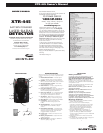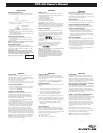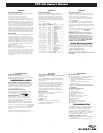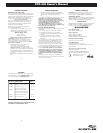
XTR-445 Owner’s Manual
• Make sure the battery contacts are clean.
• Check the fuse in the plug; replace if
necessary with a 2 amp, 3AG type.
• Check the fuse for lighter socket; replace if
necessary.
• Make sure the lighter socket is clean.
PROBLEM: Unit alarms when vehicle hits
bumps.
• Make sure the batteries are seated properly.
• Make sure that the battery door is fully
closed.
• Make sure the battery contacts are clean.
• Check for the loose lighter socket; tighten
and clean.
• Check the connections at both ends of the
power cord. Substitute another cord to
determine if the cord is defective. Return
defective cord to the factory.
PROBLEM: Audio alerts are not loud enough.
• Cancel Auto Quiet Mode or City Mode.
• Check audio level setting (see page 7 ).
PROBLEM: Low Battery Life.
• One or more of the batteries may be
defective.
• See the battery life tips on page 6.
If difficulties occur which cannot be solved by
information in this Troubleshooting Guide,
please call Whistler Customer Service at
1-800-531-0004 or visit our FAQ page at www.
whistlergroup.com, before returning your unit
for service.
PROBLEM: Unit turns itself off
• See Auto Shut Off Mode on page 11
TROUBLESHOOTING
17
Care And Maintenance
During the summer months, avoid prolonged
exposure to direct sunlight by removing your unit
from the dash when your vehicle is parked for an
extended period of time. Do not spray water,
cleaners, or polishes directly onto the unit. The
spray may penetrate through the openings and
damage the unit. Also, do not use any abrasive
cleaners on the unit’s exterior.
As with all battery operated devices remove the
batteries when the unit will not be used for an
extended period of time. Damage caused by
leaky or improperly charged batteries are not
covered under warranty.
ARE DETECTORS LEGAL?
In Most States YES!
Laser-Radar detectors are legal in every state for
automobiles and light trucks (under 10,000 lbs.)
except Virginia and Washington, D.C., which
have local regulations restricting the use of
radar receivers in any vehicle.
The Federal Highway Administration (FHWA)
passed a nationwide regulation, effective
January 1994, which prohibited radar and laser
detector use in vehicles over 10,000 lbs.
CARE AND MAINTENANCE
18
FCC ID : HSXWH15
This device complies with part 15 of the FCC
Rules. Operation is subject to the following two
conditions:
(1) This device may not cause harmful interference, and
(2) this device must accept any interference
received, including interference that may cause
undesired operation.
Important: FCC (Federal Communications
Commission) requirements state that changes
or modifications not expressly approved by
Whistler could void the user’s authority to
operate the equipment.
SPEED MONITORING
Radar Facts
A radar gun operates by transmitting radio
waves at certain frequencies which reflect off
objects and are picked up by the radar gun’s
receiving section. When a radar beam reflects
off a moving target, a measurable frequency
shift occurs. The radar unit converts this shift into
miles per hour to determine your vehicle’s speed.
Currently, the FCC permits operation of traffic
radar guns at X Band (10.500 - 10.550 GHz), K
Band (24.050 - 24.250 GHz), and Ka Band (33.400
- 36.000 GHz).
Note: A radar detector will not alarm if an
officer is not transmitting on any one of the above
radar bands.
POP™ Mode
POP
™
Mode is a feature on some radar guns
operating on K and Ka bands. When the
gun is in POP
™
Mode and activated, a brief
burst of energy, less that 1/15 of a second, is
transmitted and the vehicle’s speed is quickly
acquired. A detector without POP
™
Mode
detection capability cannot respond to this brief
transmission.
FCC INFORMATION
19
Laser Facts
It’s well documented that many radar guns
cannot reliably provide the speed of a targeted
vehicle that is traveling in a group of vehicles. In
contrast, a laser gun can target a specific vehicle
out of a line of traffic and determine its speed.
The advantage of laser over radar in terms of
target identification is the result of the laser gun’s
narrow beam. A radar gun’s transmission can
cover more than a four-lane highway at a distance
of 1,000 feet, compared with a laser gun’s
transmission which covers about 3 feet at the
same distance. For best protection, keep these
points in mind:
•Becausethevehicle’slicenseplateor
headlights are the laser gun’s primary targets,
mounting the Whistler detector on the
dashboard can improve laser detection at
short range.
•Donotfollowcloselybehindanyvehicle.Ifyou
can’t see past a vehicle ahead of you, chances
are your detector won’t either.
•Thereceivingrangeoflasersignalswill
not be the same as radar signals. Laser
guns are most often used at short range.
Whistler Laser-Radar detectors receive all current
laser guns which operate at a laser wavelength of 905
+/- 10mm.
•ProLaser
™
IIIIII•LT120-20•UltraLyte
SPEED MONITORING
20
Laser Tips
If you are the targeted vehicle, a laser gun can
often determine your speed within a few
seconds after you receive an alert. In this
situation, there is generally no time to safely
adjust your speed. However, if you are traveling
near or behind the targeted vehicle, and receive
an alert, response time should be sufficient.
Any laser alert, regardless of duration, requires
immediate action!
Other Speed Detection Systems
Several techniques other than radar or laser are
used to measure vehicle speeds. When these
methods are being used, no detector can provide
a warning. These techniques include:
•Pacing - A patrol car drives behind you and
matches your driving speed.
•Vascar/Aircraft - The time it takes a vehicle
to travel a known distance is measured.
Radar Detector Detectors: VG-2,
Spectre
The Interceptor VG-2 or simply VG-2, is one type of
microwave receiver used by Police to detect signals
radiated by the local oscillator of a radar detector.
Because its purpose is to identify persons driving
with radar detectors, these devices are known as a
“radar detector detector” (RDD).
An RDD is the primary tool used by the police to
identify radar detector equipped vehicles. If caught
in a state or country where detectors are illegal (see
page 18), drivers risk losing their radar detector
and receiving a fine. In addition, instant-on radar is
almost always used in combination with an RDD,
leaving unsuspecting motorists vulnerable to receive
two tickets - one potentially for speeding, the other
for possession of a detector.
SPEED MONITORING
21
Note: Having a radar detector capable of
detecting the VG-2 may alert you to the
presence of a speed trap. The newest tool
Police have to detect radar detectors is
called Spectre. As of this printing. Spectre
can detect the majority of undetectable (VG-
2) laser/radar detectors on the market.
It is the responsibility of the radar detector user
to know and understand the laws in your area
regarding the legality of the use of radar detectors.
WARRANTY INFORMATION
Consumer Warranty
This Whistler Laser-Radar detector is warranted
to the original purchaser for a period of one year
from the date of original purchase against all
defects in materials and workmanship. This
limited warranty is void if the unit is abused,
modified, installed improperly, or if the housing and/
or serial numbers have been removed. There are
no express warranties covering this product other
than those set forth in this warranty. All express or
implied warranties for this product are limited to the
above time. Whistler is not liable for damages
arising from the use, misuse, or operation of this
product.
Note: Damaged caused by incorrect battery
placement or battery leakage is not covered
under this warranty.
SPEED MONITORING
22







